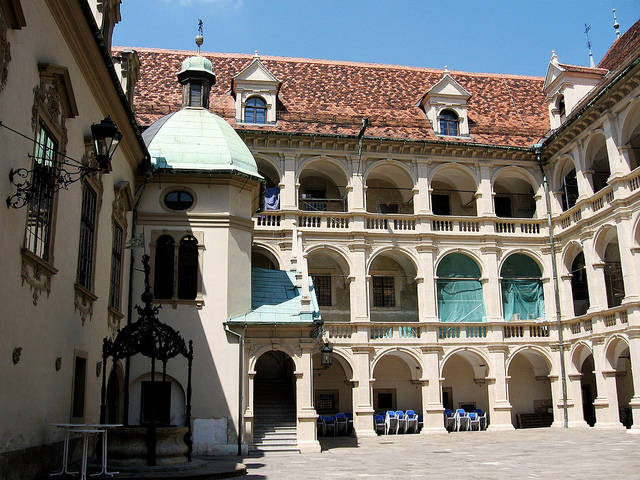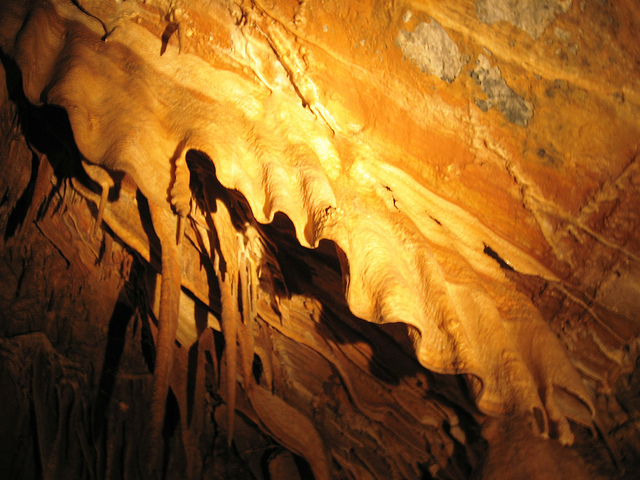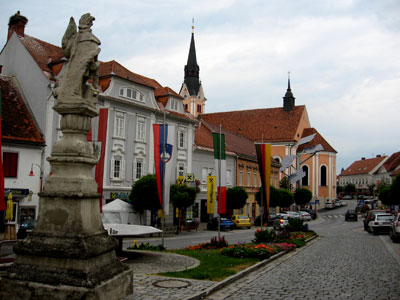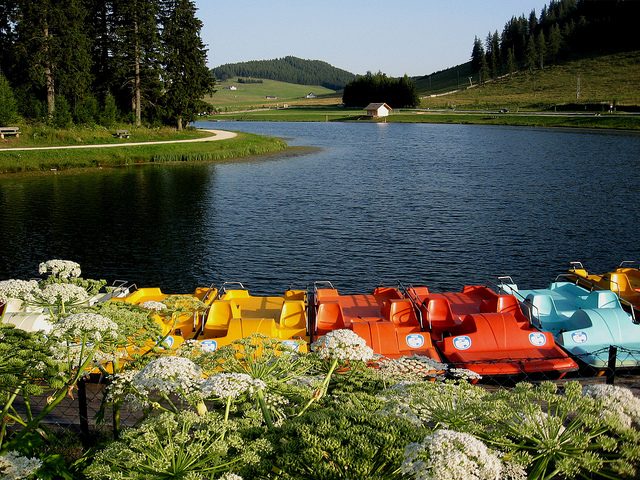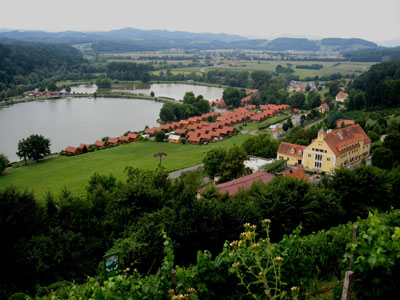Inspired from my cave adventure yesterday, I met my friends Andrea and Herbert early this morning to go on a hike through the Raabklamm (Raab River Gorge), which is surrounded by limestone mountains that hold more than 700 caves, including the famous Katerloch and the Grasshöhle, two publicly accessible caves and major tourist attractions in the Weiz area.

Landscape in Eastern Styria
Again, we drove through the rolling hills of Göttelsberg, Haselbach, Leska and Dürntal to park our car near an entrance point of the Raab Gorge. Andrea had given me a couple of Nordic Walking poles which I was about to try out for the first time. Nordic Walking, also referred to as “pole walking” or “fitness walking” is a sport that consists of walking with modified ski poles. Originally popular in Finland and Scandinavia, Nordic Walking has become extremely popular throughout Europe, although it hasn’t quite caught on yet in North America.

My friend Andrea and I, setting off on our hike
I was initially a little skeptical about the concept, but once I tried the walking poles, I realized that walking uphill and downhill both became a lot easier since the poles provide additional support and balance. And the continuous arm motion burns up to 40% more calories than walking alone and facilitates quicker movement, even on flat terrain. The additional benefit of Nordic walking is that a portion of one’s weight is distributed to the poles, which reduces the pressure on the back as well as the knee and hip joints.

The “Raabklamm”
Now convinced of the benfits of pole walking, we started our descent into the Raab River Valley on a first gently, then steeply sloping forest path. The Raabklamm is Austria’s longest gorge and divided into the “Grosse Raabklamm” (large Raab Gorge) with a length of about 10 km, and the “Kleine Raabklamm” (small Raab Gorge, about 7 km long). We were headed straight towards the Grosse Raabklamm which is the wilder of the two stretches, characterized by vertical limestone cliffs, wooden bridges, suspension bridges, walks beside the river as well as sections of the trail that veer away from the water and take you along an elevated section of the slopes. I had already explored the Kleine Raabklamm earlier last Saturday with my sister-in-law Anneliese.

One of the many bridges in the Raab Gorge
The Raabklamm itself has remained very natural and undeveloped and is home to a very diverse group of animals such as foxes, badgers as well as moufflons, a species of wild sheep that is also referred to as “goat antelopes”. Amphibians such as fire salamanders and a diverse selection of predatory birds have contributed to the Raabklamm’s designation as a protected “Natura 2000” area, a Europe-wide nature conservation area. Plant life along the steep limestone cliffs also includes remainders of ancient pine forests and a variety of alpine plants.

View of the Raab Gorge
We only covered a section of the entire Grosse Raabklamm and occasionally hiked next to the river, and at other times we hiked away from the river along the slopes of the gorge. My friend Herbert used a couple of the suspension bridges to demonstrate the laws of physics and started shaking the contraption while Andrea and I were walking across. Fortunately the suspension bridges are quite sturdy and all the trails and ladders are well-maintained. After an hour and a half of hiking we arrived at the hydro dam that is part of the local hydro electricity generating system. This area of Austria was electrified in the late 1800s, primarly at the initiative of local electricity pioneer Franz Pichler.To this day hydro-electric power delivers about two thirds of all electricity used in Austria and my home town of Weiz was one of the centres of early hydro power generation.

Austrian rural gastronomy – Gasthaus Reisinger
After admiring some fairly ancient looking hydro generating equipment we hiked back up to the local country road and drove back in my car, which we had parked earlier, to our point of origin. Andrea and Herbert had to leave and I was planning to continue my excursion to Graz, the provincial capital. But before that I had to nurture my appetite, and I was just a minute away from a well-known local restaurant whose Austrian delicacies were certain to hit the spot. Gasthaus Reisinger is one of the restaurants located next to the Raabklamm. Actually the Austrian concept of “Gasthaus” is a good deal more rustic and down-to-earth than the North American “restaurant”. A Gasthaus (literally translated: “guest house”) will usually serve solid traditional Austrian food; frequently it will also feature an outdoor patio since eating in the fresh air is very popular in Austria; and many Gasthäuser also offer overnight accommodation with breakfast.

A hearty Austrian specialty: a “Mulbratlbrot”
This is indeed the case with Gasthaus Reisinger which does not only offer Austrian cuisine and a beautiful patio, but also functions as a bed and breakfast, mostly for guests from places like Vienna or other more urban parts of Austria and Germany. I sat down to admire the lengthy menu and decided on two local specialties: a “Fritattensuppe” (pancake strip soup), an item that I always have to eat several times when I am back home, as well as a “Mulbratlbrot” – a piece of Austrian rye bread, covered with a thin layer of butter and thin slices of a special tender cut of smoked pork, topped with horseradish.

The owner of the inn
Rye bread covered by a variety of different cold cuts or smoked meats is a typical in-between meal in Austria, and they are also a popular snack for hikers and visitors of a “Buschenschank” (a restaurant serving rustic local foods owned and operated by a local wine farmer). On this perfect day the sun was shining down and I thoroughly enjoyed the peaceful and serene rolling hills of Eastern Styria. Once again I realized that the area I grew up in was a truly beautiful neck of the woods. The owner of the restaurant, Mr. Reisinger, brought me my meal and we started chatting a bit about the fact that I was actually a local who had emigrated to Canada more than 20 years ago. He on the other hand used to work full-time in maintainence in a local wood processing plant until a few years ago when his elderly parents started to require full-time care. Since that time he has been running his hospitality establishment full-time together with his wife and children, a typical Austrian family-based business.

Healthy Austrian cows
The meal was delicious and after picking up an icecream for dessert I was perfectly prepared for my next destination: Graz, the capital of Styria and the second-largest city in Austria. Just minutes from the restaurant I stopped my car to have a look back at these rolling hills, one of my favourite areas when I grew up, and to chat with some cows that were lounging around a large pasture.

Curious beasts
